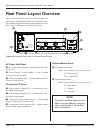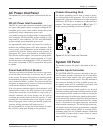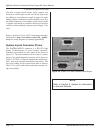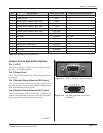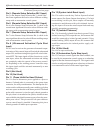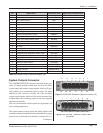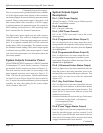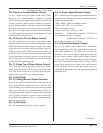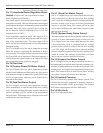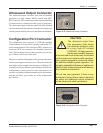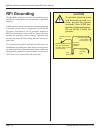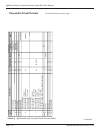
Pin 9 (System Overload Status Output)
Pin 9 is a digital active low status output that activates
whenever any overload condition is tripped. Activation
of the overload status output signal could be caused by an
average overload, a positive peak overload or a negative
peak overload condition. After the overload status output
activates, it will remain active until the next ultrasound
activation cycle begins and this output will automatically
reset. This output will be an open circuit when no overload
conditions have been detected.
Pin 10 (System On-Line Status Output)
Pin 10 is a digital active low status output that activates
when the system is in the ON LINE operating mode, which
enables the activation of the ultrasonic output. This output
will be an open circuit if the system is switched to the OFF
LINE operating mode, which will prevent the start of a
welding cycle or activation of the ultrasound output. Note
that an automation controlled process can not weld any
parts, if the system is, accidentally or otherwise, switched
to the OFF LINE operating mode.
Pin 11 (Press Top of Stroke Status Output)
Pin 11 is a digital active low status output that activates
when the press/thruster head is in the top of stroke posi-
tion. This output will be an open circuit when the press/
thruster head is not at the top of stroke position.
Pin 12 (Not Used)
Pin 13 (Analog Monitor Signal Common)
Pin 13 is the signal common (ground) connection for all
of the analog monitor signals (on Pins 15 and 16). This
signal common pin is connected to system chassis ground
and is not isolated from the generator chassis. This is an
analog signal ground connection. Do not connect anything
to this ground connection, except the wiring to the inputs
of the analog instrumentation devices used to measure the
monitor output signals.
Pin 14 (Not Used)
Pin 14 is connected to the system chassis ground.
Pin 15 (Power Signal Monitor Output)
Pin 15 is an analog output signal used to monitor the power
output from the welding system. The scaling on this output
signal is as shown below:
15kHz, 20kHz, 30kHz and 40kHz systems
1 Watt = 0.001 VDC (1mV per Watt)
50kHz and higher systems
1 Watt = 0.010 VDC (10mV per Watt)
Examples: 20kHz system measures 0.525 VDC on
Power Monitor Output = 525 Watts
50kHz system measures 0.525 VDC on
Power Monitor Output = 52.5 Watts
Pin 16 (Amplitude Monitor Output)
Pin 16 is an analog output signal used to monitor the
system amplitude setting. The scaling on this output sig-
nal is 100% amplitude = 10.0 VDC, or 0.1 VDC per 1%
amplitude. This monitor signal output would typically
be used when a remote control option board is installed
in the system. The automation control system will adjust
the system’s amplitude setting remotely, using a 4-20mA
current loop attached to the input of the remote control
board. Using this monitor output, the control system can
verify that the amplitude is set to the expected programmed
amplitude level.
Continued from previous page
Continued
Page 25
Dukane Manual Part No. 403-575-00
Section 3 - Installation




